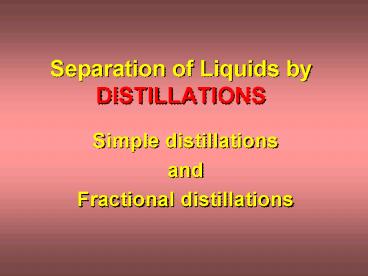Separation of Liquids by DISTILLATIONS - PowerPoint PPT Presentation
1 / 37
Title:
Separation of Liquids by DISTILLATIONS
Description:
The LOWER curve shows the composition of the liquid that boils at a given temperature. ... mixture of 80% A and 20% B boils at about 85o C. But, -- what is the ... – PowerPoint PPT presentation
Number of Views:68
Avg rating:3.0/5.0
Title: Separation of Liquids by DISTILLATIONS
1
Separation of Liquids byDISTILLATIONS
- Simple distillations
- and
- Fractional distillations
2
Start setting up with a suitable ring
stand.Tighten the rod so it will not wobble!
3
Start setting up NEAR A WATER OUTLET!Place the
burner on the ring stand next.
4
Then, add the iron ring, leaving 2-3 inches for
the flame.
5
The wire gauze goes on top of the iron ring.
6
The RB flask is clamped directly on top of the
wire gauze. Leave NO air space!
7
Put your mixture and boiling stone into the pot
BEFORE you assemble the apparatus
8
The 3-way adapter (still head) is added on top
the RB flask.
9
A thermometer is fitted through the rubber holder
AND the glass adapter. The assembly is inserted
into the still head.
10
The thermo-meter bulb should be just below the
opening to the side-arm of the still head.
11
The attached condenser is secured to another
ring stand. Water enters the lower end.
12
A graduated cylinder serves as the receiver.
Clamp it in place if necessary.
13
Hotplates are now available if you prefer !Heat
transfer??
14
- For FRACTIONAL DISTILLATIONS, A PACKED COLUMN
MUST BE INSERTED BETWEEN THE RB FLASK AND THE
STILL HEAD.
15
The condenser, still head, and thermometer
assembly are removed,leaving theRB flask
16
Put your mixture and boiling stone into the pot
BEFORE you assemble the apparatus
17
A column, packed with beads and/or rings, is
clamped to the RB flask.
18
The still head is added to the top of the packed
column.
19
The thermometer assembly is inserted into the
still head, as before.
20
The condenser is clamped to the still head. Water
enters the LOWER end.
21
A graduated cylinder is clamped to the stand to
serve as a receiver.
22
Hotplates are available if you prefer.Heat
transfer??
23
- Interpreting the composition boiling point
diagram. - Its on page 12 in your laboratory manual and on
page 322ff. of Zubrick.
24
The LOWER curve shows the composition of the
liquid that boils at a given temperature.
- The UPPER curve shows the composition of the
vapors that occur at that same temperature.
25
A mixture of 80 A and 20 B boils at about 85o C.
- But, -- what is the compositon of the vapors??
26
The VAPORS have a composition of about 47 A and
53 B.
- Those VAPORS condense back to a LIQUID of 47 A
and 53 B.
27
THAT LIQUID will boil at about 60o C
28
Those VAPORS have a composition of about15 A
and 85 B
- When condensed, the LIQUID will have that same
composition 15 A and 85 B
29
THAT LIQUID will boil at 45o C,
30
The VAPORS rising will have a composition of
about ummm3 4 A and 96 97 B.
- Note that if the vapors are richer in the LOWER
boiling component, then the composition of the
liquid in the pot must be getting richer in the
HIGHER boiling component
31
When the VAPORS condense back to a LIQUID . . .
- . . .well, I believe you can see where this is
going . . .
32
Can you figure it out!?!
- Im sure you can . . .
33
O.K.??
- O.K !!
34
(No Transcript)
35
(No Transcript)
36
(No Transcript)
37
Check the bulletin board to see if you are on
CLEAN-UP.
- Record your data FIRST, then complete your
Laboratory Report Forms. - Trim off the ragged edges and
- Turn them in along with the Recrystallization
Reports from last week .































